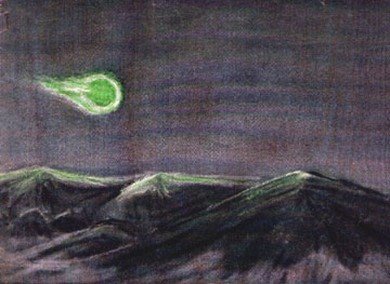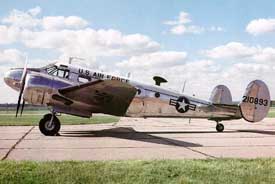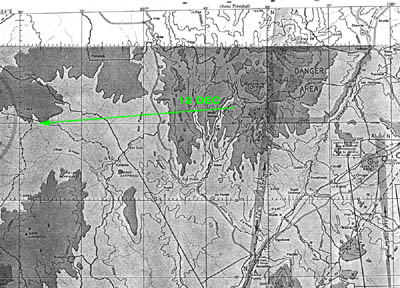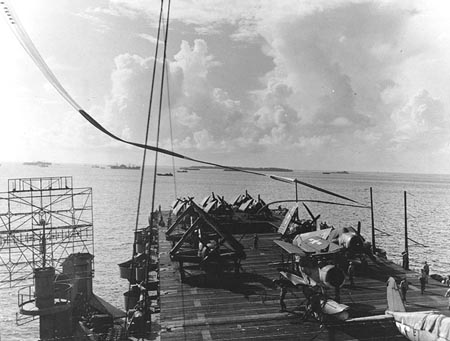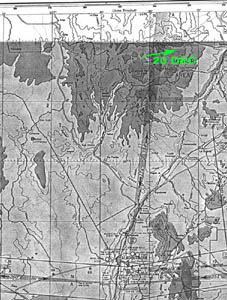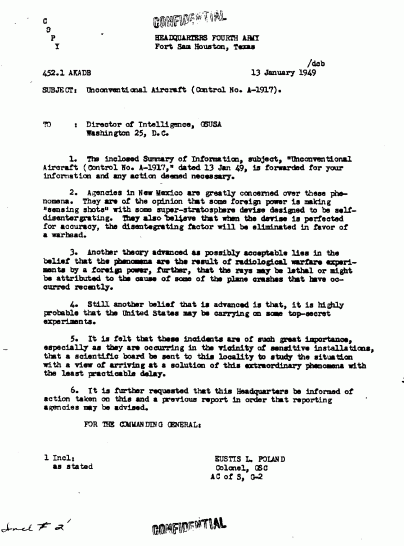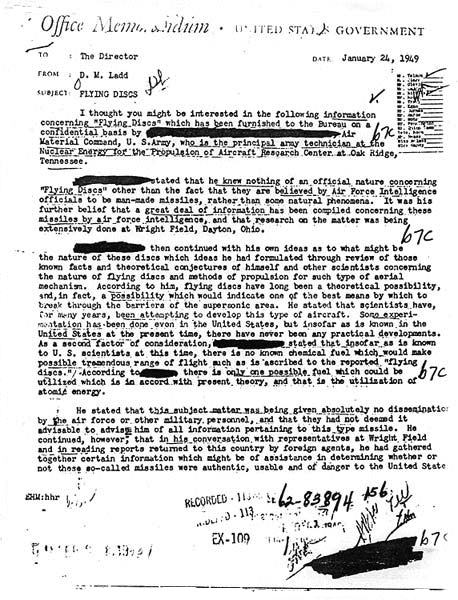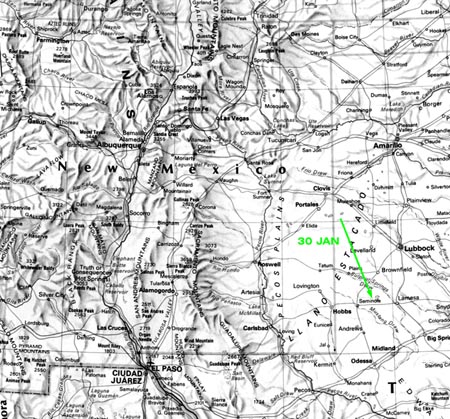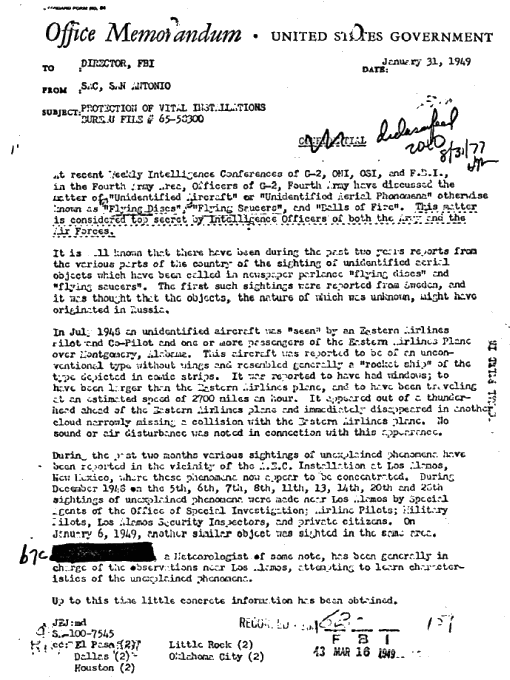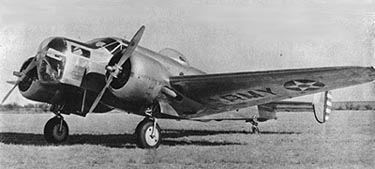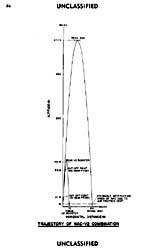Green Fireball Chronology
By
Joel Carpenter
1946-February
1949
Note:
This material is drawn primarily from personal memoranda and correspondence
of Dr Lincoln LaPaz, a New Mexico-based meteor expert and mathematician.
The documents are preserved in LaPaz's personal papers as well as the
files of the Air Force, DOE and FBI. LaPaz had been involved with
tracking the Japanese Fu-Go bomber-balloons during WWII in addition
to other wartime work with military applications of ballistics (the
Proximity Fuze program, for example). In early 1948 he was approached
by Project SIGN to act as scientific consultant to the UFO program,
but declined due to his teaching duties, suggesting instead his Proximity
Fuze project colleague Dr J Allen Hynek of Ohio State University. LaPaz's
notes make it clear that he came to believe early on that the strange
luminous phenomena being reported in New Mexico from late 1948 were
Soviet missile experiments of some type - or at the very least, highly
classified domestic secret weapons tests. But surprisingly, his papers
reveal that as early as 1947 he was already intent on this theory, even
racing to recover the famous Norton County, Kansas meteorite because
he suspected that it might be a manmade object coming from the USSR.
Spring 1946
California
Institute of Technology astrophysicist Fritz Zwicky, (who also works for
Theodore von Kármán's Aerojet company as director of research), proposes
installation of shaped-charge explosives in rockets for hypersonic research.
Zwicky points out that these weapons can accelerate particles to speeds
of 8 km/sec or more -- orbital speeds or above -- and when launched to
extreme altitudes on a large rocket, they may be usable as a tool to simulate
meteor dynamics in the upper atmosphere.
December
1946
Zwicky secures
cooperation of Army Ordnance officers and obtains payload space in a V-2
rocket for use in his dramatic experiment. The proof-of-principle launch
will be conducted at night to allow visual and photographic observation
of the artificial meteors produced by ejection of small Army rifle grenades
at high altitude. When the shaped charges are fired, they will produce
jets of iron or copper particles that should be briefly visible as meteor-like
trails. Dr James Van Allen of the Johns Hopkins University Applied Physics
Laboratory supervises installation of the test equipment in the V-2 warhead.
Actual construction of the grenade launcher assembly is handled by the
New Mexico School of Mines in Albuquerque.
16 December
1946
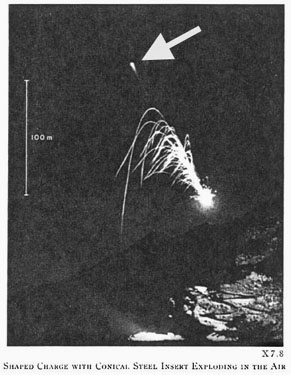
In calibration
of the imminent experiment, rifle grenades are launched to low altitude
at night from the Organ Mountains near the White Sands missile range launch
site and are photographed by telescopes and cameras. Arrow, above, indicates
supersonic slug of incandescent iron emerging from rifle grenade and producing
a simulated meteor.
17 December
1946
Zwicky has
recruited many professional and amateur astronomers and meteor observers
to help track the flight of the missile; they are positioned at sites
all over New Mexico and into Arizona. Over 30 cameras are installed within
a 20-mile radius of the launch site, including an 8-inch Schmidt telescope
shipped from Mt Palomar, California. Other cameras are carried aloft in
aircraft to assist in triangulation of the rocket's path. In addition,
astronomers Vesto M Slipher, of the Lowell Observatory at Flagstaff, Arizona;
Edwin F Carpenter, at Kitt Peak, Arizona; and Lincoln LaPaz (a noted authority
on meteors) at Albuquerque, are primed to track the test. The 18-inch
Schmidt telescope hundreds of miles away at Mt Palomar is trained on the
sky over White Sands as well, but poor weather obstructs its view.
V-2 number
17 is launched at 10:12 PM MDT on a vertical trajectory, aimed for maximum
altitude. Its engine burns for 70 seconds, longer than any other V-2 in
the entire US flight test program, and a peak velocity of over 5,400 feet
per second (nearly 3,700 mph) is achieved. The rocket streaks to an altitude
of some 116 miles before exploding. Ground observers as far away as Arizona
are able to easily track the rocket's exhaust, and even after the engine
runs out of fuel, its glowing nozzle components are clearly visible as
it soars into space. Unfortunately, the artificial meteors are never seen;
the conclusion is that the grenades may not have fired.
Zwicky is
determined to pursue the experiments and has ambitious plans to launch
similar shaped-charge artificial meteors from multistage rockets, balloons,
artillery pieces, and aircraft. He is obstructed, however, by Harvard
astronomer Fred Whipple, an influential member of rocket science committees,
who reverses his earlier support for the project and now steadfastly refuses
to allow further such experimentation on the grounds that the technology
is immature and unreliable. Whipple unaccountably accuses Zwicky of misuse
of public property and threatens to sue him. Zwicky will only be permitted
to conduct another similar experiment in October 1957, but he remains
angry about Whipple's obstructionism for decades.
On December
11-12, 1950, Whipple heads a White Sands upper-atmosphere research project
called "T-Day" in which launches of four Army Signal Corps Aerobee
sounding rockets equipped with grenade charges are conducted in parallel
with Signal Corps high-altitude balloon flights and a night launch of
the large Navy Viking VI rocket, all timed to coincide with the maximum
of the Geminid meteor shower. Zwicky is excluded from the event.
The early
phase of the Green Fireball phenomenon, December 1948-February 1949
5 December 1948
At 9:05 PM
MST, the crew of a USAF C-47 transport flying from Lowry AFB, Colorado,
to Williams AFB, Chandler, AZ, sees a green flarelike light just west
of Las Vegas, NM. At 9:30 they report by radio to Kirtland AFB, Albuquerque,
that they had seen another green flare rise from the ground to 500 ft
altitude on the eastern slope of the Sandia Mountains at 9:27.
Pioneer Air
flight 63, another C-47, radios Kirtland AFB tower that its crew had seen
a green light west of Las Vegas, NM at 9:35 while flying due west at 9,000
ft. They thought it was a "shooting star" at first, "but it
was too close to the ground." The pilot, Ernest Van Lloyd, suggests that
the light could have been a Very pistol flare. After landing, he telephones
Kirtland tower to discuss the incident. He says that when he first saw
the phenomenon it was coming straight at him and he was so startled that
he attempted to jerk the plane out of the way. The light then trailed
off to the ground. It was pale green with a pale green trail.
"When the
initial report of December 5 was made at Sandia Base, a conference was
held between Air Force, Army and Department of Justice personnel for the
purpose of evaluating this information. It is understood that a report
of this has gone to respective headquarters."
Very shortly
after these reports, University of New Mexico News Bureau head Dr Ward
Fenley drafted a press release and "transmitted" it (in LaPaz's words)
to NM newspapers in an effort to alert the public to report similar incidents.
However, the press release was halted before publication due to "pressure
from other agencies also investigating this occurrence." Secrecy about
the light phenomenon was rapidly put in place, probably on the initial
suspicion that the lights represented unknown ground-based activity.
The early incidents appeared very much like flares.
(LaPaz-Rees,
13 Dec)
6 December
Kirtland
AFB Office of Special Investigations agent S/A Melvin E Neef interviews
Van Lloyd and copilot James Smith at the Pioneer Air operations office
on the base. The pilots recount the incident but describe it differently
from their first report: as a white flash, then a whitish-orange object.
They can give no estimate of the object's size or range.
11:53 PM:
Security officer Joseph Tolouse sees a greenish flare lasting 2-3 seconds
over Sandia Base. He reports it to Neef on the 11th.
8 December
The Kirtland
OSI agents Stahl and Neef interview Capt K K Miller, New Mexico State
Police, at his headquarters in Santa Fe. He says no unusual flare reports
have come in to his office, but promises to refer any future witnesses
of flare activity to Kirtland. The agents also visit K D Flock, Santa
Fe National Forest Supervisor, in Santa Fe. Flock had received no aerial
phenomena reports in 1948, but says that in the summer of 1947 a woman
named Madeline G. Merchant had contacted
him at least five times over a six week period about sightings of flying saucers
and luminous phenomena. Flock says he will alert his rangers to watch
for unusual lights or objects, and permits the KAFB OSI agents to use
his fire towers as observation posts if desired.
The OSI agents
interview Chief of Police Matt O'Brien in Las Vegas, who also says that
he has received no flare reports. NM State Police patrolman Noland Utz
has the same news, and agrees to cooperate with the Air Force special
agents.
The agents
interview the wife of the owner of the flying service at Watson Airport
in Las Vegas, as well as J D Miller, a local CAA official, and four of
his employees. None know anything. The airport personnel say that no night
flying was originating from the field.
At 5:45 Stahl
and Neef take off from Kirtland AFB in a Beech T-7 (C-45) and fly to Las
Vegas. The weather is "CAVU" -- completely clear with unlimited
visibility. The Moon is to their right. At 6:33, while ten miles east
of the Las Vegas radio range station, heading due east, they both see
a brilliant green light about 2,000 ft above them, coming toward them
at high speed from 30 deg to their left, on a path from 60 deg ENE to
240 WSW. It is similar to a USAF green flare, but more intense and larger.
Its trajectory is flat and parallel to the ground. It lasts about two
seconds, then burns out and drops off with orange fragments. They stay
in the area for another 90 minutes but see nothing more.
